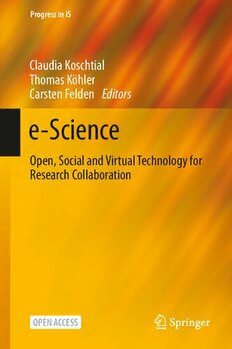Table Of ContentProgress in IS
Claudia Koschtial
Thomas Köhler
Carsten Felden Editors
e-Science
Open, Social and Virtual Technology for
Research Collaboration
Progress in IS
“PROGRESSinIS”encompassesthevariousareasofInformationSystemsintheory
andpractice,presentingcutting-edgeadvancesinthefield.Itisaimedespeciallyat
researchers,doctoralstudents,andadvancedpractitioners.Theseriesfeaturesboth
researchmonographsthatmakesubstantialcontributionstoourstateofknowledge
and handbooks and other edited volumes, in which a team of experts is organized
byoneormoreleadingauthoritiestowriteindividualchaptersonvariousaspectsof
thetopic.“PROGRESSinIS”iseditedbyaglobalteamofleadingISexperts.The
editorialboardexpresslywelcomesnewmemberstothisgroup.Individualvolumes
in this series are supported by a minimum of two members of the editorial board,
andacodeofconductmandatoryforallmembersoftheboardensuresthequality
andcutting-edgenatureofthetitlespublishedunderthisseries.
Moreinformationaboutthisseriesathttp://www.springer.com/series/10440
· ·
Claudia Koschtial Thomas Köhler Carsten Felden
Editors
e-Science
Open, Social and Virtual Technology for
Research Collaboration
Editors
ClaudiaKoschtial ThomasKöhler
TUBergakademieFreiberg MediaCenter
Freiberg,Germany TUDresden
Dresden,Germany
CarstenFelden
TUBergakademieFreiberg
Freiberg,Germany
ISSN2196-8705 ISSN2196-8713 (electronic)
ProgressinIS
ISBN978-3-030-66261-5 ISBN978-3-030-66262-2 (eBook)
https://doi.org/10.1007/978-3-030-66262-2
©TheEditor(s)(ifapplicable)andTheAuthor(s)2021.Thisbookisanopenaccesspublication.
OpenAccessThisbookislicensedunderthetermsoftheCreativeCommonsAttribution4.0International
License(http://creativecommons.org/licenses/by/4.0/),whichpermitsuse,sharing,adaptation,distribu-
tionandreproductioninanymediumorformat,aslongasyougiveappropriatecredittotheoriginal
author(s)andthesource,providealinktotheCreativeCommonslicenseandindicateifchangeswere
made.
Theimagesorotherthirdpartymaterialinthisbookareincludedinthebook’sCreativeCommonslicense,
unlessindicatedotherwiseinacreditlinetothematerial.Ifmaterialisnotincludedinthebook’sCreative
Commonslicenseandyourintendeduseisnotpermittedbystatutoryregulationorexceedsthepermitted
use,youwillneedtoobtainpermissiondirectlyfromthecopyrightholder.
Theuseofgeneraldescriptivenames,registerednames,trademarks,servicemarks,etc.inthispublication
doesnotimply,evenintheabsenceofaspecificstatement,thatsuchnamesareexemptfromtherelevant
protectivelawsandregulationsandthereforefreeforgeneraluse.
Thepublisher,theauthorsandtheeditorsaresafetoassumethattheadviceandinformationinthisbook
arebelievedtobetrueandaccurateatthedateofpublication.Neitherthepublishernortheauthorsor
theeditorsgiveawarranty,expressedorimplied,withrespecttothematerialcontainedhereinorforany
errorsoromissionsthatmayhavebeenmade.Thepublisherremainsneutralwithregardtojurisdictional
claimsinpublishedmapsandinstitutionalaffiliations.
ThisSpringerimprintispublishedbytheregisteredcompanySpringerNatureSwitzerlandAG
Theregisteredcompanyaddressis:Gewerbestrasse11,6330Cham,Switzerland
Introduction
This publication, e-science: The enhanced science, is a collection of conference
papers, reviewed and selected in a double-blind review process by a distinguished
reviewercommittee.FromtheverybeginningwhenJohnTaylorintroducedtheterm,
e-sciencedidnotonlycompriseinfrastructureasanenablerofscientificdiscovery,
butalso“globalcollaborationinkeyareasofscience”(Taylor1999).Ascomputer
technologies and digital tools pervade the academic world, it is time to ask what
changesareimpliedwhenan“e”isaddedtoscience.Whatisprimarilydiscussedin
GermanyandGreatBritainundertheterme-sciencecorrespondsintheUSAtothe
conceptofcyberinfrastructuresandinAustraliatotheconceptofe-research.
Morerecentlythediscourseaboute-sciencehasbeendealingwithcollaborative
researchthatisbasedonacomprehensivedigitalinfrastructure.Thisinfrastructure
both ultimately integrates all relevant resources for a research domain in a digital
formatandprovidestoolsforprocessingsuchdata.Incomputing-intensiveresearch
scenarios,e-scienceincludesdistributionofcomputingcapacities,supportingcollab-
orative processes of a rather inter-institutional character, such as (inter)national
networks.Theopeninnovationapproachcreatesnewplatformsfordevelopingand
publishing research results. For example the MOVING platform (http://moving-
project.eu/moving-platform/ cf. Vagliano et al. 2018) supports new collaborative
researchpracticesandhasbecomearesourceforfurtherresearch.
In this sense and in addition to the technological aspect (virtualization of hard-
ware),e-sciencealsohasasocialandpolitics-of-scienceaspect(cooperativeresearch,
reusability of data and interoperability of digital tools). Although there is the will
toexpande-sciencemethodsintothewidereconomyandsociety,thisdevelopment
is occurring slowly. New skill sets are being acquired in the e-humanities, virtual
engineering or visual analytics (Redecker and Punie 2017; Köhler 2018). Yet e-
sciencealsocomprisesopenaccess,e-learningandgridcomputing; thesechanges
areenabledbystatefundingandpublicinterest.Asaresult,theconceptofe-science
continues to generate new concepts for particular disciplines such as e-geography,
e-humanities,e-medicineore-engineering.
The 2014 International Conference on Infrastructures and Cooperation in e-
Science and e-Humanities reflected the broad ongoing discussion concerning the
changesaffectingresearchandteachinginuniversitiesnowadays.Itaddressedcurrent
v
vi Introduction
Section2:
Organizational &
sociotechnical
perspectives
s
m
s
er ct
on and t Section3: e prospe
1: Definiti perspIeTc tives n 5: Futur
Section Section4: Sectio
Cases &
experiences
Fig.1 Structureof“e-science:theenhancedscience”
questionsandsolutionsrelatedtotechnologiesorapplicationsaswellastheirimplica-
tionsfortheconductofscience.Itinvestigateddigitallyenhancedacademicinitiatives
fromtechnologicalandsocio-scientificperspectives.
This volume is subdivided into five sections representing different perspectives
one-science,asseeninthefigurebelow.Thefirstsectionintroducesthebookand
reviewstheliteratureconcerningthedefinitionofe-science.Section2providesorga-
nizationalandsocio-technicalperspectives,especiallytheuseofweb2.0toolsfrom
an individual viewpoint and the successful implementation of such tools from an
organizationalviewpoint.Ase-scienceofcourserelatestoinformationtechnology,
Section3coversITperspectives,andSection4presentsdomain-specificcasesand
experiences.Finally,theproceedingsclosewithfutureprospects(Fig.1).
The introductory section of the proceedings Digital research infrastructure: an
overviewstartsoutwithC.Koschtial’scontribution,ananalysisofthetermscovered
bythefieldofdigitalresearch,thatis,e-scienceitself,andrelatedtermslikecyber-
scienceorscience2.0.Ase-scienceisasocio-technicalsystem,itcanbeapproached
fromtheperspectiveofthehumanuser,thetaskorthetechnology,asidentifiedby
Heinrich(1993,pp.8).Theaimistoidentifythedominantapproachtoe-science,to
distinguishbetween thedifferenttermsandidentifyhowthetermsreflectchanges
intheprevailingresearchstreams.
Section2dealswithindividualusageoftoolsandorganizationalenablementof
this. The first paper of the second section, authored by T. Köhler, C. Lattemann
andJ.Neumann,isentitledOrganizingAcademiaOnline:Organizationmodelsin
e-learningVersuse-scienceCollaboration,identifiesformsoforganizationalgover-
nance enabling effective e-collaboration for scientists. Organizational governance
Introduction vii
captures (social, output or behavioural) controls that are suitable for effective e-
collaborationinscientificcommunities.Basedonthreecasestudies,theauthoridenti-
fiesITasakeyfactorinsuccessfulvirtualizationandconcludesthatthereisaneedfor
virtualizedorganizationmodelswhichrefertoprocessesandstructure.Thesecond
contributionfrominthissectionbyB.MohamedandT.Köhlerinvestigatesindividual
researchersandtheirwilltouseweb2.0tools.Inthethirdpaper,focusonconcep-
tualizing and validating digital research collaboration between novice researchers.
BasedontheFISHmodel,anonlinesurveyof140noviceresearcherswascarriedout
andanalysedusingPartialLeastSquaresfortheanalysisofthedata.Onemainresult
is that successful usage of online tools enhances the belief in web 2.0 as a useful
instrument.Thesecondmainresultisthatbenefitsexperiencedbysharingenhance
motivation for collaboration. Based on an online study comparing Germany as a
wholewiththefederalstateofSaxony,thefinalcontributionofthesecondsection
authored by S. Albrecht, C. Minet, S. Herbst, D. Pscheida and T. Köhler presents
researchintotheextenttowhichdigitaltoolsareadopted.Onefindingisthatcertain
toolsarenowusedbymorethanthehalfofthescientistsintheirdailyprofessional
life,butweb2.0toolslikemicroblogsandsocialnetworkingsitesareusedfarless
often.
In Section 3, the focus is on digital tools or information infrastructures, which
have not been considered yet. The first paper contributed by O. Schonefeld, M.
StührenbergandA.Wittinthissectiondiscussesimportantguidelinesforresearch
infrastructures,whichareusedtosupportteaching,researchandyoungresearchers.
RegardingIT,researchinfrastructuresshouldbemaintainedincollaborationbetween
organizations. To reduce costs, energy efficient or green, technologies should be
considered,andsecurenetworksareneededenablingtominimizerisks.Concerning
the aspect of information infrastructure, the authors stress the relevance of data
repositoriesandpublicationserversinaformatthatallowsthestoreddocumentsor
datatobeusedinthelongterm.Furtherimportantconsiderationsregardingresearch
infrastructuresincludecopyrightlawswithspecificnationalregulationsandpersonal
data protection. Accordingly, the authors identify a need for an IT strategy and
correspondingrolessuchasthatofdataprotectionofficerinorganizationsproviding
aresearchinfrastructure.
ThesecondpaperauthoredbyA.Apaolaza,T.Backes,S.Barthold,I.Bienia,T.
Blume,C.Collyda,A.Fessl,S.Gottfried,P.Grunewald,F.Günther,T.Köhler,R.
Lorenz, M. Heinz, S. Herbst, V. Mezaris, C. Nishioka, A. Pournaras, V. Sabol, A.
Saleh, A. Scherp, U. Simic, A.M.J. Skulimowski, I. Vagliano, M. Vigo, M. Wiese
andT.ZdolšekDrakslerintroducesMOVING:AUser-CentricPlatformforOnline
LiteracyTrainingandLearning.Theplatformenablestheusageofmachinelearning
forsearching,organizingandmanagingunstructureddatasources.Thedatasources
comprisebutarenotlimitedtopublications,videosorsocialmedia.Thecontribution
presentsthewebplatformfromauser-centredperspectiveinordertogiveanoverview
ofthefunctionalities.
Thefinalpaper ofSection3fromG.Heyer andV.Boehlke presents aresearch
infrastructurecalledCLARIN-D.Thisisaweb-basedplatformforthee-humanities,
used to collect and provide digital content, with the services needed to store the
viii Introduction
content.Oneofthemostimportantelementsinsearchcontentismetadata,whichis
showntobeusefulforfindingdataandalgorithms.
Section 4 presents cases and experiences in the field of e-science. In the first
paper,M.HeidariandO.Arnoldshowthatfullydigitalizedscholarlyactivitiessuch
asonlineexaminationscanhaveahighvariability,whichpresentsamanageability
challenge.Theauthorsanalysethevariabilityoflegallyanalogueexamprocessesand
provethenecessityforestablishingmanagementmodels.Theauthorsofthesecond
paper,DesigningExternalKnowledgeCommunicationinaResearchNetwork:The
Case of Sustainable Land Management, examine factors influencing the knowl-
edge communication process. The aim is to find factors in successful communi-
cation between researchers and stakeholders as a representation of collaboration.
The authors describe steps that need to be taken to enable successful communica-
tion:formulatetheproblem,analysethesituation,definecommunicationobjectives,
identifytargetgroups,formulatethemessageanddevelopacommunicationstrategy
andactivities.S.Münster’spaper,ResearchingScientificStructuresViaJointAuthor-
ships:TheCaseofVirtual3DModellinginHumanitiesisthelastinSection4.This
case study of scientific structures is an analysis of co-authoring for a defined set
of conferences. The topics are interdisciplinarity, number of publications and co-
authoring, and multipliers. The author identifies multipliers for knowledge in the
fieldof3Dmodelling.
Finally, in Section 5, A. Skulimowski presents a Delphi study trying to shed
somelightonfuturedevelopmentsine-science,especiallyinselectedITtechnolo-
gies. He focuses on two emerging systems, brain-computer interfaces and global
expertsystemsthatprocessdatabases,communicationandunstructuredformatslike
videos.Thesesystemsmayleadtocollectiveratherthancollaborativeresearch,as
one researcher cannot manage the volume of information alone anymore. Another
scenariobasedontheautomateddataanalysesisthatpaperscanbeproducedalmost
completely with minimal human intervention. In any case, Skulimowski paints an
interestingpictureofthefutureofscience.
We hope that you will find this an interesting collection of a wide range of
perspectives,whichcontributestoyourideasandvisionsofe-science.
Acknowledgements
First of all, the conference was part of the e-science Network of the Technische
Universität Bergakademie Freiberg, Technische Universität Dresden and Leipzig
UniversityofAppliedSciences.Thisconferenceandtheresultingpublicationhave
been enabled and financially supported by the European Social Fund ESF and the
Saxon State Ministry of Science and Culture, whom we want to thank herewith.
Additionally, we want to thank Dean Prof. Dr. Andreas Horsch for his financial
supportinordertomakethebookavailableasopenaccesspublication.
The editors especially want to thank all the authors whose contributions give
thisvolumeitsspecialquality,andfortheirpatientsupportthroughouttheprocess
Introduction ix
of publication. Furthermore, we want to thank all reviewers for their helpful and
progressenablingcomments,enhancingthequalityofallcontributions.Wewantto
thankDominikWuttkeaswellasIliaVershininfortheirexacttransferofallthepapers
to LNCS. For the language correction, we want to thank Dr. Kate Sotejeff-Wilson
forhersupportandqualityassurance.
Wewishyou,thereaders,inspiringreading!
Freiberg/Dresden,Germany ClaudiaKoschtial
Spring2020 ThomasKöhler
CarstenFelden
References
Heinrich,L.J.:Wirtschaftsinformatik.OldenbourgVerlag,München(1993)
Köhler,T.:Researchtrainingfordoctoralcandidatesinthefieldofeducationandtechnology.In:
Drummer,J.,Hakimov,G.,Joldoshov,M.,Köhler,T.,Udartseva,S.(eds.)VocationalTeacher
EducationinCentralAsia.DevelopingSkillsandFacilitatingSuccess.Springer,Berlin(2018)
Redecker,C.,Punie,Y.:EuropeanframeworkforthedigitalcompetenceofeducatorsDigCompEdu.
PublicationsOfficeoftheEuropeanUnion,Luxembourg(2017)
Taylor, J.: e-Science. http://www.e-science.clrc.ac.uk, https://web.archive.org/web/200102222
31418/,http://www.e-science.clrc.ac.uk/(1999).LastAccessed18Feb2020
Vagliano,I.,Guenther,F.,Heinz,M.,Apaolaza,A.,Bienia,I.,Breitfuss,G.,Blume,T.,Collyda,C.,
Fessl,A.,Gottfried,S.,Hasitschka,P.,Kellermann,J.,Köhler,T.,Maas,A.,Mezaris,V.,Saleh,
A.,Skulimowski,A.M.J.,Thalmann,S.,Vigo,M.,Wertner,A.,Wiese,M.&Scherp,A.:Open
innovationinthebigdataerawiththeMOVINGplatform:Anintegratedworkingandtraining
approachfordata-savvyinformationprofessionals.IEEEMultiMedia25,3,8–21,July–Sept.
2018(2018)

